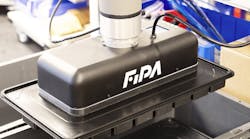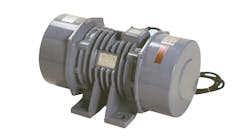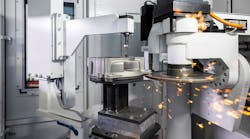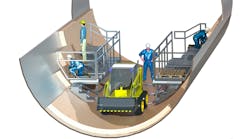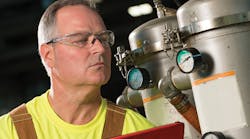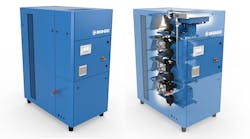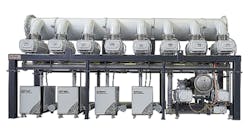OERLIKON LEYBOLD VACUUM systems for steel degassing include pumps and components that meet the specification of ATEX Cat 2 (i) G IIC T2. This equipment can be combined into ATEX-certified vacuum systems, and with the additional gas cooling and temperature control between the pumps it will prevent gas temperatures from exceeding the defined limits. All pumps are controlled and monitored by a specially programmed frequency converter.
Oerlikon Leybold Vacuum offers vacuum technologies for manufacturing and analytical processes, as well as for research purposes.
The demand for higher-quality, refined steels has increased steadily. At the same time, steel producers operate under increasing pressure to maintain energy efficiency and reduce CO2 emissions.
Higher-grade steels for automotive or aerospace industry require secondary treatment, often carried out under vacuum. Degassing, especially with oxygen injection, as in VOD and RH-OB methods, produces potentially explosive gases. Vacuum components and equipment with ATEX approval enable safe and cost-efficient mechanical processes.
“Today’s international standards for mechanical vacuum systems are based on the latest generation Roots-type vacuum pumps and dry screw-type vacuum pumps. Selecting such modern mechanical pump solutions also offers outstanding process control possibilities, and employs a very reliable design, enabling the pumps to survive inside the harsh steel plant environment,” according to Uwe Zoellig, Oerlikon’s senior manager for the Process Industry market.
“By installing standard pumps in multiple arrangements, even highest suction requirements can be fulfilled with competitive pricing, while focusing on high safety standards,” he continued.
Describing degassing, addressing risks
In all processes for steel degassing under vacuum, gases and vapors are formed that might be dangerous. Essentially, CO and H2, as well as the vapors of volatile metals, are released from the steel surface. Metal and metal-oxide vapors partially condensate on cold plants elements and generate a fine dust. That dust must be efficiently separated in special bag filters, cyclones, and containers and therefore does not reach the vacuum pumps.
Explosion protection in vacuum plants, especially those that generate a large quantity of CO by using oxygen for decarburization, so far has been assured by over-pressure flaps at the metallurgical reaction vessels, alarm devices for water leakage, sensors for pressure and temperature as well as emergency venting with nitrogen.
With the introduction of mechanical vacuum pumps, efficient installations for gas cooling and dust separation became necessary.
During a typical steel degassing process, potentially flammable fuels as CO or H2 are produced, but the appearance of such gases alone does not create a danger. If the gas is mixed in the right concentration with oxygen, the gas mixture becomes dangerous. Therefore, oxygen represents a quite substantial threat for the assessment of explosion risks.
Yet, oxygen cannot be eliminated, as leakages cannot be ruled out completely, and the use of oxygen is mandatory for certain manufacturing processes. However, the user should reduce the introduction of oxygen to the minimum. For this reason the usage of primary vacuum pumps that require cooling by the inlet of large amounts of ambient air (air-blast cooling) is not recommended, as this additional air will increase the chances to build up an explosive gas-mixture.
Today, the standard mechanical vacuum pumps already meet high standards for safety. Nevertheless, in case there are uncertainties regarding the flammability of gas mixtures which need to be handled by the pump sets, the user will have to conduct a risk analysis of the various plant parts to define the relevant explosion protection zones. The result will most probably be the definition of an explosion Zone 1 for the inner part of the vacuum system.
For this assessment, components with an ATEX-certificate Category 2 (inside) for gases are an easy solution that allow users to reach the highest safety standard for employees with relatively low investment expenditure. The same considerations are also valid for all vacuum processes with forced decarburization, like VD-OB and RH-OB, or for processes with natural decarburization like VCD as well as for the VD-degassing of fully killed steel grades in presence of a reactive slag, especially in connection with higher leak rates. The off-gas composition and the moment of appearance of flammable mixture are very different in these processes.
Regarding the vacuum pump set, potential ignition sources, such as overheating or electrostatic charging must be considered, which will be achieved with the usual attention during design and manufacturing of ATEX-certified pumps. In particular, the pumps must be protected efficiently against overload by too high pressure differences in order to avoid excessive temperatures.
This is valid for all possible operating point starting with high suction pressures, passing to medium operating pressures, that are to be hold over a longer time as for example during delayed pump down in the VD-process or during the oxygen blow phase in the VOD-process, down to lowest end pressures with its high compression ratios.
Visit www.oerlikon.com/leyboldvacuum
